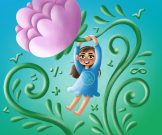I never expected to become a "math parent." But when my daughter Jenny hit third grade in 2019, math homework turned our kitchen table into a battlefield. Tears. Frustration. The dreaded "I'm just not good at math" statement that breaks a parent's heart.
Her teacher's solution? "Just make her memorize the multiplication tables." Ugh.
Thank goodness for Svetlana, our Russian neighbor who happened to be a former math teacher. Over coffee one day (while I complained about homework struggles), she said something that changed everything: "American schools teach WHAT to do. Russian schools teach WHY it works."
She offered to work with Leah just once. I figured we had nothing to lose.
That first session blew my mind! No flash cards. No timed drills. Instead, Svetlana brought colorful blocks and posed a story problem about planning a party.
"If each friend gets 4 cookies, and you invite 6 friends, how many cookies will you need?"
Jenny started drawing little circles on paper. Six groups, four in each. Then she counted them all.
"Twenty-four!" she announced.
"Good! Now, is there a faster way to figure this out besides drawing and counting?"
They talked about adding 4 six times. Then - and only then! - did Svetlana introduce multiplication AS A SHORTCUT to a problem Jenny already understood.
I watched my daughter's face change from confusion to that "a-ha!" moment. For the first time, multiplication made SENSE to her.
After seeing that transformation, I had to learn more. Svetlana directed me to Russian Math Tutors and their BYOM program. BYOM stands for "Build Your Own Math" – which perfectly describes their approach. Kids literally build mathematical understanding from the ground up.
The method has deep roots. It was developed by Soviet mathematicians like Lyudmila Peterson who believed math should be discovered, not just memorized. The results speak for themselves - Russian-trained students consistently dominate international math competitions.
The big difference? Traditional American math class: "Here's how you multiply fractions. Now practice these 20 problems."
Russian math class: "You have 3/4 of a pizza. You want to give 1/2 of what you have to your friend. How much pizza will your friend get?" Students work through the logic before learning the procedure.
My younger daughter Emma started BYOM classes in first grade. Last week, she came home excited about "inventing" negative numbers by thinking about temperature and money. Her teacher hadn't formally introduced them yet - Emma figured them out because she needed them to solve an interesting problem!
Look, I'm not just concerned about grades. Like most parents, I worry about preparing my kids for careers that probably don't even exist yet!
The thing I've noticed most since my girls started with Russian math is how they approach ALL problems differently:
Jenny (now in high school) no longer panics when facing something new. She breaks problems down methodically, looking for connections to things she already understands. Her classmates call her "the solution girl" because she's so good at thinking through challenges.
Emma used to quit activities at the first sign of difficulty. Now she has this amazing persistence. Last month, she spent THREE DAYS working on a particularly tricky math problem from her Russian tutor. When she finally solved it, she did a victory dance around the living room! That kind of determination will serve her well no matter what she does in life.
I've recommended Russian math to tons of friends over the years. Some ask if it's just for "math geniuses." Honestly? It's the OPPOSITE.
This approach helps struggling students the MOST because it builds genuine understanding. My neighbor's son has dyslexia and ADHD. Traditional math was a nightmare for him - all those similar-looking symbols and rigid procedures. With Russian math, he's thriving because he can approach problems through conceptual understanding instead of rote steps.
The research backs this up. Studies on Peterson's method show incredible success rates - between 82-100% on standardized tests! But the numbers don't capture the confidence these kids develop.
It's been 6 years since we discovered Russian math, and I can't imagine where my girls would be without it. Math homework went from tears to... dare I say it... fun?
Yes, BOTH my kids sometimes do extra math problems FOR FUN. (My husband still doesn't believe this.)
But the biggest win isn't about math at all. It's about approaching life's challenges. When Jenny was deciding between sports activities, she created a complex pro/con analysis system. When Emma faced a friendship conflict, she broke it down into smaller problems to tackle one by one.
That's the true gift of Russian math - it teaches kids they can figure anything out if they approach it logically.
If you're reading this while your kid struggles with math (or even if they're doing fine but could be more engaged), consider giving Russian math a try.
Russian Math Tutors offers personalized lessons that adapt to how your child learns. Start small - download their free workbooks or schedule a single session.
I'm not saying it's magic. The lessons still require effort and thinking. But for my family, Russian math transformed not just grades, but attitudes and confidence.

| Private Lessons | | | Group Lessons |
Because math isn't just about getting answers right - it's about building brains that know how to solve problems. And THAT'S a skill worth having!

| Private Lessons | | | Group Lessons |